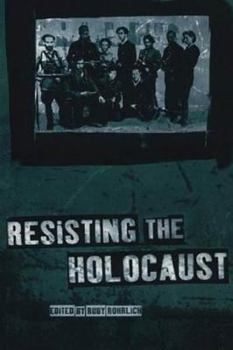Resisting the Holocaust
Select Format
Select Condition 
Book Overview
Although much has been written about the resistance to the Holocaust, public discussion still almost exclusively focuses on the resistance of male non-Jews. This reader seeks to redress the imbalance by looking at resistance from the perspective of the victims, almost exclusively Jewish and, in some cases, female. Their resistance embraces a variety of actions and movements, passive and active, performed by individuals, groups and nations. Leading scholars from a wide range of disciplines - including anthropology, history, politics, and sociology - supply us with engrossing accounts of individual resisters, family groups, movements, and the resistance of entire nations. Contributions cover: - Primo Levi and Survival in Auschwitz - The Auschwitz Children's Camp- The Warsaw Ghetto Youth Movement- Intermarriage in Nazi Germany- Jewish Women in the French Resistance- Foundations of Resistance in German-Occupied DenmarkThis book places the fact of Jewish resistance in a new light and represents an important sourcebook on studies of the Holocaust, German and Jewish history.
Format:Paperback
Language:English
ISBN:185973216X
ISBN13:9781859732168
Release Date:October 1998
Publisher:Bloomsbury Publishing PLC
Length:264 Pages
Weight:0.75 lbs.
Dimensions:0.6" x 5.4" x 8.4"
Customer Reviews
2 ratings
Repetition as Resistance
Published by Thriftbooks.com User , 25 years ago
Resisting the Holocaust is the last work of Ruby Rohrlich, a feminist foremother who died in December 1999. The book comprises 12 essays about resistance during the Holocaust by Jews and non-Jews that gave this non-Jewish newcomer to the topic a broad introduction to the discussion of what did and still does make for resistance to Hitler's genocidal scheme. Adding to the richness of topics covered is the range of fields the contributors cover: anthropology, communications, government, history, humanities, literature and sociology.Rohrlich's introduction stresses that the "key concept" of her book is "'resistance'"--whether it is resistance termed "active" or "passive" and regardless of what form resistance may take. Equally absorbed by the themes of armed resistance by Jews, assimilation and intermarriage, individual acts of resistance and national acts such as the grand-scale rescue of Jews in Denmark, I found many connections within this collection and to events beyond its scope. These pieces gave me insight not only into the Holocaust but also into the genocide committed against my own Armenian ancestors during and before World War I.The story of the armed fighting in the Vilna Ghetto (chapter 4) highlights the tensions that can arise within an oppressed group when some members struggle to fight while others have no faith anyone will survive. The "Parachutists' Mission" of three Jewish women from Eastern Europe (chapter 6) raises questions about the creation of national symbols at the expense of certain truths about the motives and sacrifices these national symbols make and the collective, rather than solitary, nature of their actions. One of the three women--Hannah Senesz--was made a national symbol in Israel of Jews saving Jews from Nazis. Senesz's real life story is more complex than the myth. A less discussed kind of story involves kinship groups that women formed in concentration camps, where, the author writes, "Forming a family in Auschwitz was an act of resistance at the personal level, because it gave life meaning and offered support and hope" (chapter 8).If it is true, as Martin Cohen states (chapter 2). that "[t]here has been, and remains, both organizational and scholarly avoidance of the issue of resistance," then the publication of Resisting the Holocaust helps break this silence. Indeed, good books keep readers thinking after their last page. Resistance to the Holocaust--to all genocides--continues in the actions people take. Publication of Resisting the Holocaust can be seen as one such action, because it tells and retells pertinent stories and thus encourages the continual discovery of connections among them.--30--
Resistance to Holocaust ranges - individuals-groups-nations
Published by Thriftbooks.com User , 26 years ago
Resisting the Holocaust Ruby Rohrlich, editor Oxford and New York: Berg Publishers, 1998. 264 pp. Notes, bibliography, and index.It is the contention of the editor and some of the contributors to this fine collection that "resistance" to the Holocaust is a topic that has been severely neglected. This contention is hard to contradict at a time when it is reported that one of the few older works on the subject, Reuben Ainsztain's _Encyclopedia of the Jewish Resistance_, has been deaccessioned by the Cleveland public libraries. So, let it be said up front that this is an important work, one that will help considerably in countering that historical neglect--or will if it is added to library collections. Like any collection of works by a variety of authors and with a wide range of foci, the parts of this book vary significantly in both quality and interest. But, the quality is mostly high and the topics are generally of compelling interest.Ruby Rohrlich introduces the book with a consideration of the concept of "resistance," which she reports has been defined in various ways to cover everything from armed struggle against the Nazis to anything done by Jews to survive--and even to any humane actions by non-Jews towards Jews. While never explicitly resolving the definition to be used for this volume, her introductory remarks and the substance of the following essays clearly come down towards the active resistance end of the spectrum. Rohrlich is particularly concerned to counter the assumption that resistance to the Holocaust was a male activity, which she does effectively through brief descriptions of the heroic activities of "little Wanda" Teitelboim, Mala Zimetbaum, and Germaine Ribiere. She points out that resistance was often collective, and in the cases of the Bulgarians, the Italians, and the Danes the collectivity apparently involved the majority of their populations. Having laid out the parameters of the problem, Rohrlich briefly summarizes each chapter and lets the reader get on with the essays.· Copyright © 1999 by H-NetReviewer: Stan Nadel is an Associate Professor of History in the Social Sciences Department at Southwestern Oklahoma State University





